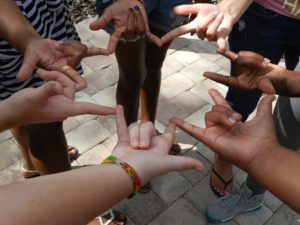
September is International Deafness Awareness Month
When I wrote a Deaf heroine for my latest novel, Submerged Hopes, I was intrigued by the idea that a hindrance which she struggled with day to day could be an asset while diving. Though I have several family members who became deaf later in life, they don’t identify as Deaf, so I did a lot of research, and I’m grateful to my Deaf beta readers. It was a challenge to write the point of view of a non-hearing person, and made me grateful for all the day-to-day little sounds I take for granted.
Deaf with a capital D refers to people who identify with Deaf culture. They often sign, but not always. When the word is spelled in lowercase, it refers to the hearing loss itself. Thus, my father is deaf but not Deaf.
Hearing loss can be early or late, and can be caused by a myriad of factors, from systemic illness like infections to problems with the ear itself. Deaf people don’t have mental deficiencies, yet apparently they are often told, “you don’t look deaf,” or “you speak really well for a Deaf person.” The term “hearing-impaired” is also offensive, because it implies that something is wrong/the person is less than.
For some people, hearing aids can be helpful, but they don’t work for everyone–it’s the same for cochlear implants. How a person manages hearing loss is highly personal, so it’s intrusive and insulting to say, “Why don’t you just get implants / hearing aids / learn to read lips?”
Lip-reading is hard, and depending on the language, even best case scenario only about thirty percent of what is said can be picked up, because the rest of the sounds are formed inside the mouth or the throat, and thus not visible. It also depends on lighting.
If one is talking with a deaf person, look directly at them, but don’t exaggerate facial movements or “rubber lip”–it’s as offensive as speaking louder to someone who doesn’t understand English, and it doesn’t help. Lip-reading is difficult enough that some Deaf people wear buttons which note that they don’t hear, to clue in people to speak clearly and face-on.
Of course, now the use of masks with the Covid-19 outbreak has made life much more difficult for Deaf people who relied upon lip reading. There are some who are now making clear masks to try to get around this. Is there an awareness ribbon for hearing loss? Yes: it’s gold and silver.
Sign language takes years to learn, so not all Deaf people sign. Sign language is unique to the country a person dwells in; it’s not universal. When a person interprets sign language from a Deaf speaker, they are said to “voice” or interpret from them, not translate.
Famous Deaf people include Ludwig von Beethoven, Lou Ferrigno, who played The Incredible Hulk, Hellen Keller, the actress Marlee Matlin, Granville Redmond, whose impressionist paintings are now worth six figures, the model Nyle DiMarco, and the NFL player Derrick Coleman, Jr. There are many others, of course!
What’s the best way to interact with a Deaf person? First and foremost, remember that they are a person, and the hearing loss is only a small part of who they are.
Recent Comments